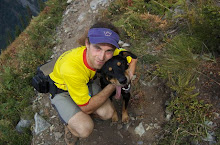But the Professor is back on the dais which brings us to today's lesson delivered during the heart of baseball season.

It's known in most circles simply as "The Catch". Willie Mays made an outstanding play in the 1954 World Series by chasing down a fly ball hit over his head and catching it on the fly. Many people think it is the best defensive play in the history of baseball.
Oscar McLovin is here to tell you that we shouldn't get so carried away by Mays's dramatic display. The Professor performs this same feat at least once a day during our ball-throwing session. Let's compare the human to the canine:
- Mays catches the ball on the fly whereas McLovin allows it to bounce once or twice. Advantage: Mays
- Mays needs special equipment to catch a ball whereas McLovin doesn't. Advantage: McLovin
- Mays made his catch in a pressure-packed situation whereas McLovin doesn't know what pressure is. Advantage: Mays
- Mays caught his ball with his hands (a part of the body ideally designed to perform such tasks) whereas McLovin catches balls with his mouth. Advantage: McLovin
- Mays had to wait for the ball to be hit to take off whereas McLovin generally anticipates where the ball is going to be, taking off before the ball is thrown his way. Advantage: Tie
- Mays made his catch once in his lifetime whereas McLovin makes the catch routinely. Advantage: McLovin
I'll let you decide which version of "The Catch" is more impressive but the spectator wins wither way as each one is fun to watch.

"Mays had to wait for the ball to be hit to take off whereas McLovin generally anticipates where the ball is going to be, taking off before the ball is thrown his way. Advantage: McLovin"
ReplyDeleteI must protest. First, like all decent outfielders, Mays *did* position himself in anticipation of where the ball would likely end up by his selection of where to stand. Second, and far more important, it needs mentioned that McLovin's "anticipation" typically takes the form of him running in one direction and then trusting that the ball be thrown in that direction, which it almost always is. In the rare exceptions to this pattern, that is, when the ball is thrown in the opposite direction, it has been my observation that McLovin typically stands around for a few seconds looking confused and then runs up to the nearest bush and pees on it. I never saw Mays doing that on, say, a grounder to third. I'd say: advantage = tie.